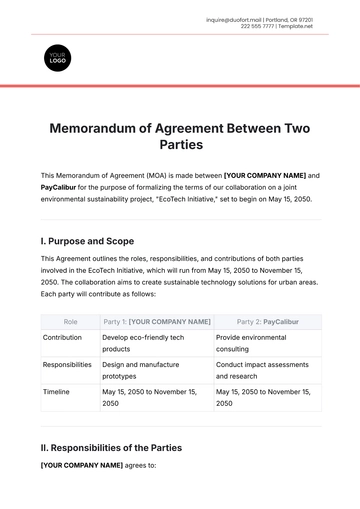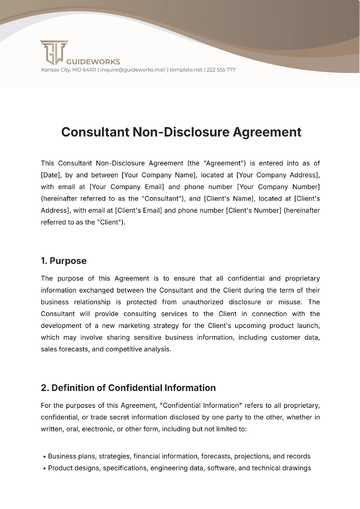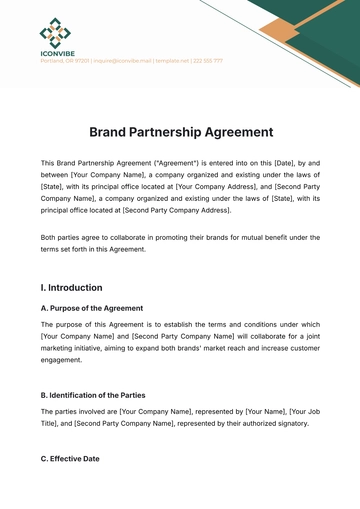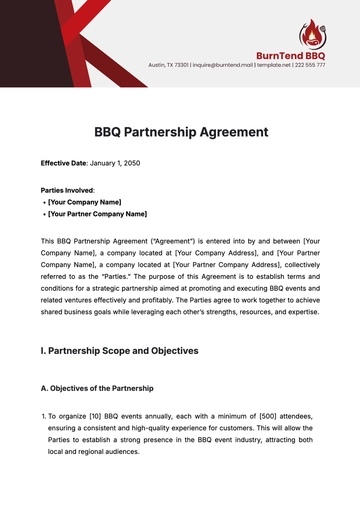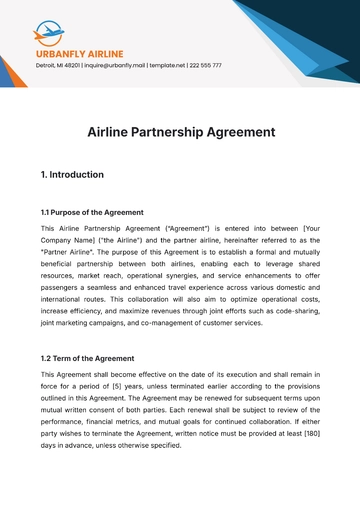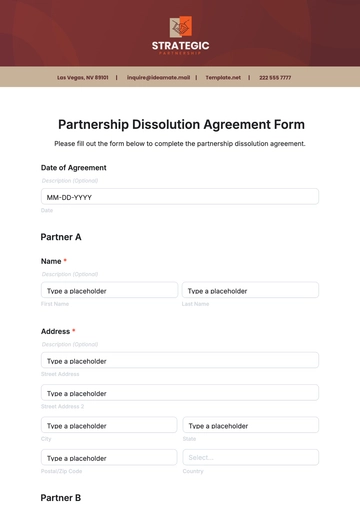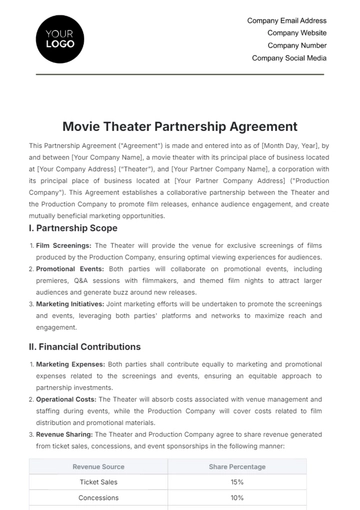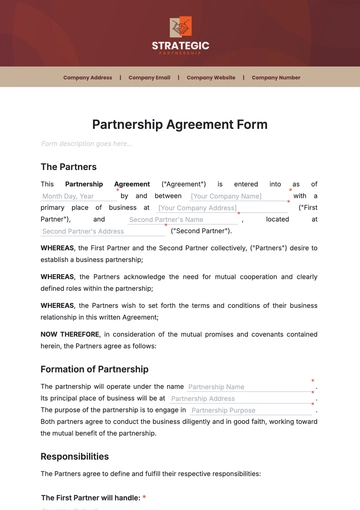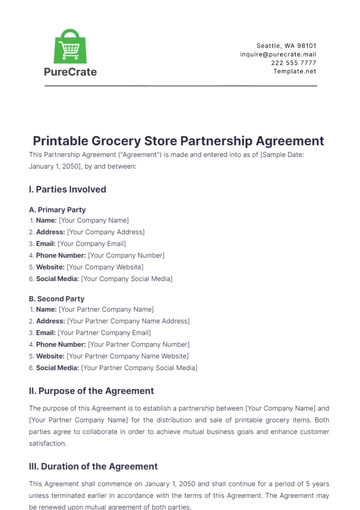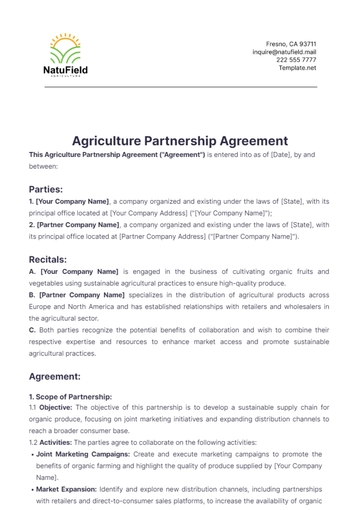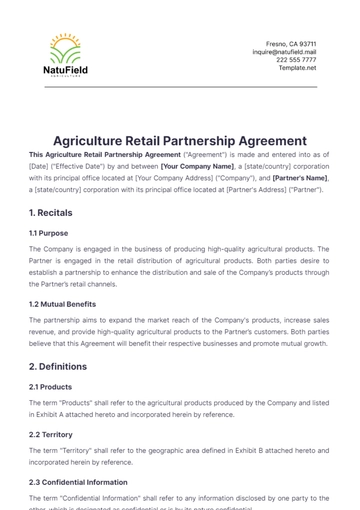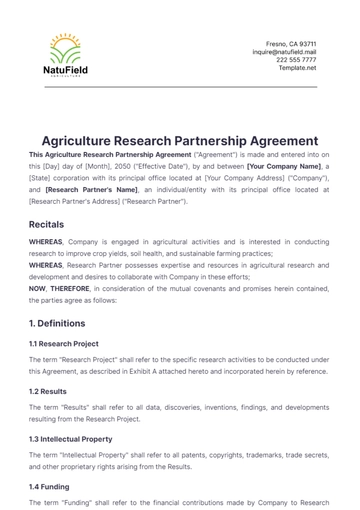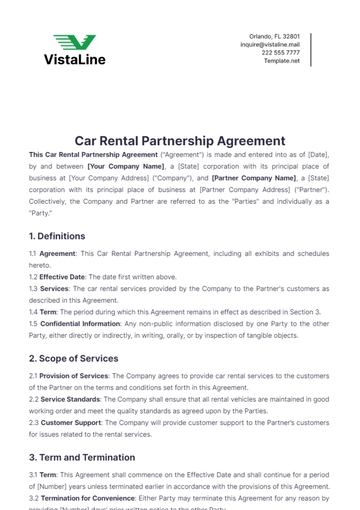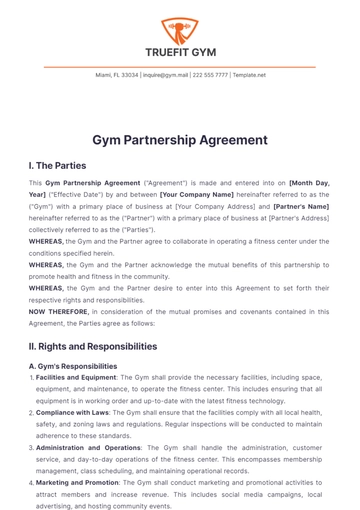Free Sales Partnership Agreement for Joint Deals
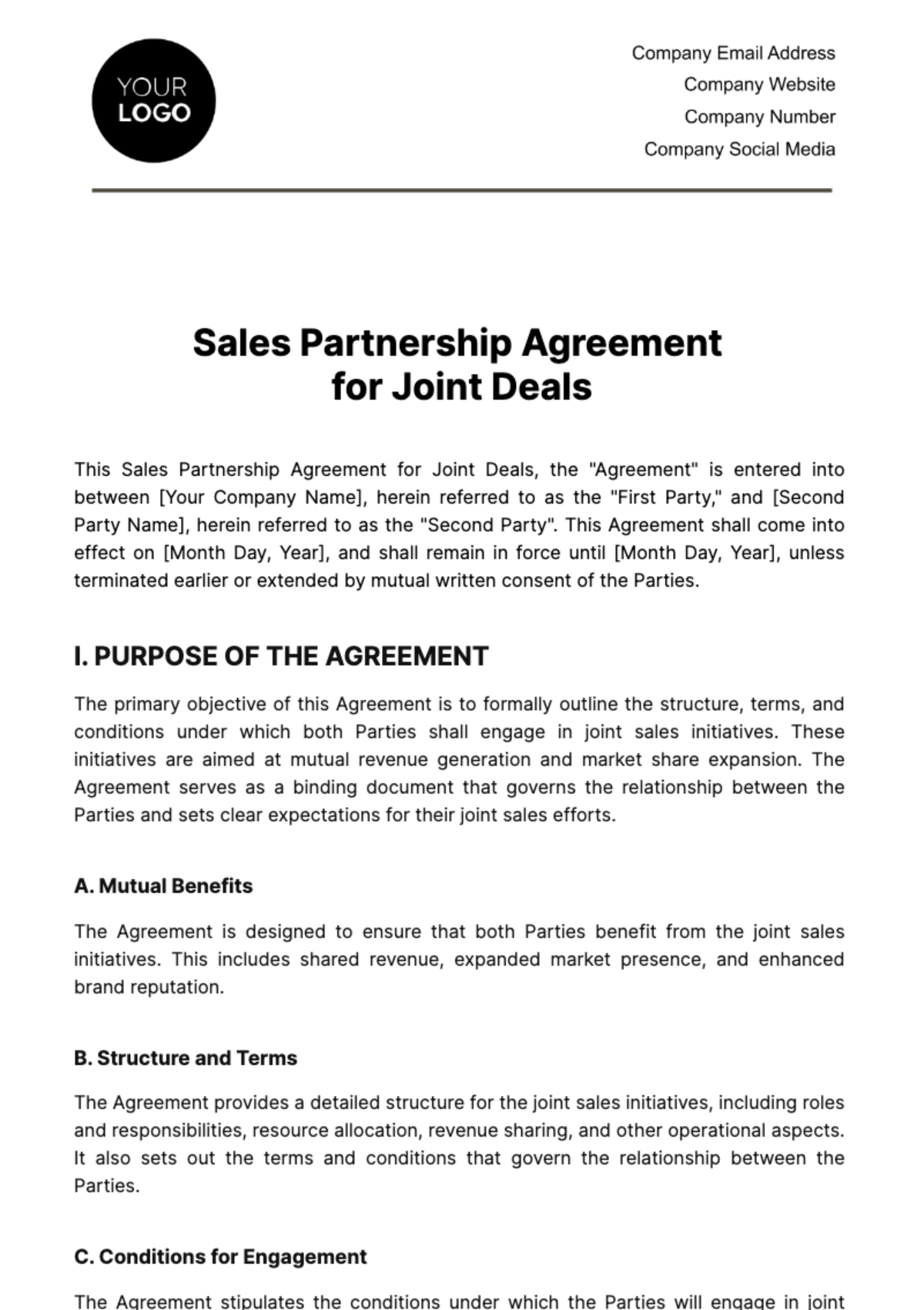
This Sales Partnership Agreement for Joint Deals, the "Agreement" is entered into between [Your Company Name], herein referred to as the "First Party," and [Second Party Name], herein referred to as the "Second Party". This Agreement shall come into effect on [Month Day, Year], and shall remain in force until [Month Day, Year], unless terminated earlier or extended by mutual written consent of the Parties.
I. PURPOSE OF THE AGREEMENT
The primary objective of this Agreement is to formally outline the structure, terms, and conditions under which both Parties shall engage in joint sales initiatives. These initiatives are aimed at mutual revenue generation and market share expansion. The Agreement serves as a binding document that governs the relationship between the Parties and sets clear expectations for their joint sales efforts.
A. Mutual Benefits
The Agreement is designed to ensure that both Parties benefit from the joint sales initiatives. This includes shared revenue, expanded market presence, and enhanced brand reputation.
B. Structure and Terms
The Agreement provides a detailed structure for the joint sales initiatives, including roles and responsibilities, resource allocation, revenue sharing, and other operational aspects. It also sets out the terms and conditions that govern the relationship between the Parties.
C. Conditions for Engagement
The Agreement stipulates the conditions under which the Parties will engage in joint sales initiatives. This includes compliance with applicable laws and regulations, adherence to ethical business practices, and respect for each other’s intellectual property rights.
II. DEFINITIONS
A. Joint Deal
A Joint Deal refers to a strategic sales opportunity wherein both Parties combine resources, expertise, and market influence to facilitate the acquisition, conversion, and onboarding of a customer.
B. Lead
A Lead refers to an individual or business entity that has expressed interest or is deemed likely to be interested in the goods or services being offered.
C. Revenue
Revenue refers to the comprehensive financial income generated through successful Joint Deals. This encompasses initial sales, upsells, and recurring payments.
D. Sales Activity
Sales Activity refers to discrete tasks or initiatives conducted with the explicit aim of driving sales. These activities range from lead generation and nurturing to the actual sales pitch, negotiation, and closing of deals.
E. Resource Allocation
Resource Allocation refers to the strategic distribution of various operational assets committed by each Party to ensure the effective execution of joint sales initiatives.
F. Confidential Information
Confidential Information refers to any proprietary data, trade secrets, business plans, and any other information disclosed by either Party in the course of implementing this Agreement.
III. SCOPE AND RESPONSIBILITIES
The primary goal of this Agreement is to foster a collaborative environment for Joint Deals, specifically targeting market segments where both Parties’ products or services provide complementary value. The aim is to leverage synergies to boost customer acquisition and revenue growth.
A. Joint Sales Strategy
Market Analysis: Both Parties will collaborate to analyze the market, identify potential opportunities, and understand the competitive landscape. This will help in positioning their offerings effectively.
Lead Generation: The Parties will jointly develop and execute lead generation strategies. This could involve a combination of inbound and outbound marketing tactics.
Customer Engagement: The Parties will work together to engage with potential customers. This could involve conducting product demos, hosting webinars, or organizing customer meetups.
Sales Conversion: The Parties will jointly handle the sales negotiations and deal closures. They will leverage their combined negotiation power and industry expertise to convert leads into customers.
B. Resource Allocation
Sales Personnel: Each Party will allocate experienced sales personnel who understand their products/services and the target market. These personnel will be responsible for customer engagement and sales conversion.
Technology Platforms: Each Party will provide access to their technology platforms that can aid in sales and marketing activities. This could include CRM systems, marketing automation tools, or analytics platforms.
Market Intelligence: Each Party will share relevant market intelligence that can help in making informed decisions. This could include insights about market trends, customer behavior, or competitive activities.
C. Lead Generation and Qualification
Lead Generation: Both Parties will contribute to generating sales leads by leveraging their individual databases and marketing channels. This could involve activities like email marketing, content marketing, or social media marketing.
Lead Qualification: The Parties will jointly qualify the leads based on predefined criteria. This ensures that the sales efforts are focused on the most promising leads.
D. Sales Activities
Presentations and Proposals: The Parties will jointly prepare and deliver sales presentations and proposals. This ensures that the potential customers get a comprehensive view of the combined offerings.
Negotiations: The Parties will jointly handle the sales negotiations. This allows them to leverage their combined negotiation power to secure favorable deal terms.
E. Revenue Sharing
Revenue Sharing Formula: The Parties agree to a revenue-sharing formula that reflects their respective contributions to the Joint Deals. This formula will be outlined in a separate annexure to this Agreement.
Revenue Apportionment: The revenue generated from the Joint Deals will be apportioned based on the agreed-upon formula. This ensures that each Party gets a fair share of the revenue.
IV. SALES TARGETS AND METRICS
In alignment with the overarching objectives of this Agreement, both Parties will agree on clearly defined sales targets. These targets will be set for varying time frames with an additional focus on Key Performance Indicators (KPIs) that are integral to the success of Joint Deals.
A. Sales Targets
Quarterly: The revenue target for each quarter is $[250,000], with a new customer target of [50]. These targets are set to ensure a steady growth rate and to maintain a consistent sales performance throughout the year.
Semi-Annual: The semi-annual targets will be defined based on the performance during the first two quarters and the market trends observed during this period. This allows for adjustments and recalibrations to align with the changing market dynamics and customer behavior.
Annual: The annual targets will be set considering the overall market conditions, the performance during the year, and the strategic objectives of both Parties. This long-term perspective ensures that the partnership remains focused on achieving sustainable growth.
B. Key Performance Indicators (KPIs)
Customer Lifetime Value (CLV): This metric represents the total net profit that a customer is expected to contribute over their lifetime. It helps in understanding the long-term value of the customer and in making decisions about customer acquisition and retention strategies.
Average Deal Size: This metric represents the average revenue generated from each deal. It provides insights into the profitability of the sales efforts and helps in identifying opportunities for upselling and cross-selling.
Sales Conversion Rate: This metric represents the percentage of leads that are converted into customers. It provides insights into the effectiveness of the sales process and helps in identifying areas for improvement.
Lead-to-Customer Ratio: This metric represents the number of leads required to acquire a new customer. It provides insights into the efficiency of the lead generation and qualification processes.
C. Reporting and Corrective Action
Each Party shall designate a representative responsible for reporting progress toward achieving sales targets and KPIs. These reports will provide a comprehensive view of the sales performance and will serve as a basis for strategic decision-making.
These reports shall be made available on a monthly basis and shall be subject to verification by both Parties. This ensures transparency and mutual accountability in the partnership.
In case either Party fails to meet the agreed-upon sales targets or KPIs, a corrective action plan shall be mutually developed and implemented. This could involve revising the targets, enhancing the sales strategy, or making strategic alterations to the sales processes. This ensures that the partnership remains agile and responsive to changing circumstances.
V. REVENUE SHARING AND FEES
Both Parties agree to a revenue-sharing model that accurately reflects their respective contributions to the Joint Deals. The model will be dynamic, allowing adjustments for changes in market conditions, strategic focus, and other key factors.
Type of Deal | Revenue Share to First Party | Revenue Share to Second Party |
Standard Deal | 60% | 40% |
Premium Deal | ||
Exclusive Deal |
A. Fees for Value-Added Services
Technical Support: There will be specific fees for providing technical support. This could involve activities like troubleshooting, software updates, or user training. The aim is to ensure that the customers get the most value out of the products/services.
Customer Onboarding: There will be fees for customer onboarding activities. This could involve activities like account setup, data migration, or user training. The aim is to ensure a smooth transition for the customers and to help them get started with the products/services quickly and efficiently.
Marketing Initiatives: There will be fees for conducting joint marketing initiatives. This could involve activities like hosting webinars, participating in trade shows, or running joint promotional campaigns. The aim is to increase the visibility of the Joint Deals and to attract potential customers.
B. Financial Transactions
All financial transactions under this Agreement shall be conducted in US Dollars unless mutually agreed otherwise. This ensures consistency and simplicity in financial management.
Payment timelines shall be defined explicitly, with the standard term being Net Thirty (30) from the invoice date. This ensures that both Parties have a clear understanding of the payment expectations and can manage their cash flows accordingly.
C. Record Keeping and Audits
Both Parties shall maintain accurate records of all transactions related to this Agreement. This ensures transparency and accountability in the financial dealings.
Each Party has the right to request and conduct financial audits to ensure compliance with the agreed revenue-sharing model and fee structure. This ensures that the financial dealings are fair and in accordance with the Agreement.
D. Taxes and Compliance
Each Party shall be responsible for all taxes, charges, and other governmental fees associated with their share of the revenue. This ensures that each Party fulfills its tax obligations.
Parties shall share requisite tax documents, ensuring full compliance with applicable laws and regulations. This ensures that the partnership operates within the legal framework and avoids any potential legal issues.
VI. CONFIDENTIALITY
A. Confidentiality Obligations
Scope of Confidentiality: Both Parties shall maintain strict confidentiality regarding all proprietary, sensitive, and non-public information disclosed, generated, or accessed during the execution of this Agreement. This obligation extends to all employees, agents, and third parties acting on behalf of either Party.
Purpose of Confidentiality: The purpose of this confidentiality obligation is to protect the proprietary and sensitive information of both Parties from unauthorized disclosure or misuse.
Duration of Confidentiality: The confidentiality obligations shall remain in effect even after the termination of this Agreement until such information enters the public domain.
B. Use of Confidential Information
Permitted Use: The confidential information shall be used solely for the purposes delineated in this Agreement. This ensures that the confidential information is used in a manner that is consistent with the objectives of this Agreement.
Prohibited Use: Any other use of the confidential information is strictly prohibited unless expressly authorized in writing by the disclosing Party. This ensures that the confidential information is not misused or exploited for unauthorized purposes.
Unauthorized Disclosure: In case of any unauthorized disclosure of confidential information, the Party responsible for such disclosure shall promptly notify the other Party and take all necessary measures to prevent further disclosures.
C. Protection of Confidential Information
Protection Measures: Both Parties shall take all reasonable measures to protect the confidentiality of the information. This includes implementing appropriate physical and electronic security measures.
Awareness and Compliance: Both Parties will also ensure that all employees, agents, and third parties are aware of and comply with these confidentiality obligations. This ensures that the confidential information is adequately protected at all times.
Breach of Confidentiality: In case of any breach of the confidentiality obligations, the Party responsible for the breach shall promptly notify the other Party and take all necessary measures to mitigate the impact of the breach.
VII. AMENDMENTS
A. Amendment Procedure
Agreement on Amendments: Any modifications to this Agreement must be mutually agreed upon in writing by authorized representatives of both Parties. Once a consensus has been reached, such changes shall be documented and ratified in writing by authorized representatives of both Parties.
Legal Enforceability: This ensures that any changes to the Agreement are formally agreed upon and documented, thereby ensuring that they carry legal weight and are enforceable.
Notification of Amendments: Any amendments to the Agreement shall be promptly notified to all relevant stakeholders to ensure that they are aware of the changes and can adjust their actions accordingly.
B. Documentation of Amendments
Amendment Documentation: All amendments to this Agreement shall be documented in a written amendment signed by authorized representatives of both Parties.
Clarity of Amendments: The amendment shall clearly state the changes being made to the Agreement, the reasons for the changes, and the effective date of the changes. This ensures that all Parties have a clear understanding of the changes and their implications.
Accessibility of Amendments: The amendment documents shall be made accessible to all relevant stakeholders to ensure transparency and accountability.
C. Legal Effect of Amendments
Integration of Amendments: Once ratified, the amendments shall become an integral part of this Agreement and shall have the same legal effect as the original provisions of the Agreement.
Enforceability of Amendments: This ensures that the amendments are legally binding and enforceable, just like the original provisions of the Agreement.
Compliance with Amendments: All Parties shall comply with the amendments and adjust their actions accordingly to ensure continued compliance with the Agreement.
VIII. GOVERNING LAW
A. Jurisdiction
Governing Law: This Agreement shall be comprehensively governed by, construed, and interpreted following the laws and statutes of the jurisdiction in which the First Party is formally registered, without giving effect to any choice or conflict of law provision or rule.
Legal Compliance: This ensures that the Agreement is legally sound and complies with the laws of the relevant jurisdiction.
Dispute Resolution: Any disputes arising out of or in connection with this Agreement shall be resolved in accordance with the laws of the relevant jurisdiction.
B. Compliance with Local Laws
Local Law Compliance: Both Parties agree to comply with all applicable laws and regulations of the jurisdiction in which the First Party is formally registered. This includes, but is not limited to, laws relating to business operations, tax, employment, and intellectual property.
Legal Obligations: This ensures that both Parties fulfill their legal obligations and operate within the legal framework.
Regulatory Updates: Both Parties shall keep themselves updated about any changes in the applicable laws and regulations and adjust their actions accordingly to ensure continued compliance.
C. Amendments and Governing Law
Amendment Compliance: Additionally, both Parties agree that any alterations to the Agreement must be carried out in strict accordance with the regulatory framework of said jurisdiction and are contingent upon a mutual written agreement between the Parties.
Legal Soundness of Amendments: This ensures that any changes to the Agreement are legally sound and enforceable under the governing law.
Notification of Legal Changes: Both Parties shall promptly notify each other about any changes in the governing law that could potentially impact the Agreement or its execution.
IX. SIGNATURES
By signing below, both Parties acknowledge their understanding and acceptance of the terms laid out in this Agreement.
[Signature]
[Authorized Representative Name]
[Your Company Name]
First Party
Date: [Month Day, Year]
[Signature]
[Second Party Name]
Second Party
Date: [Month Day, Year]
- 100% Customizable, free editor
- Access 1 Million+ Templates, photo’s & graphics
- Download or share as a template
- Click and replace photos, graphics, text, backgrounds
- Resize, crop, AI write & more
- Access advanced editor
Establish effective partnerships for joint deals with the Sales Partnership Agreement for Joint Deals Template available only on Template.net! This tool is editable and customizable helping you outline the terms and conditions of your partnerships, promoting effective collaboration and mutual success. Generate your agreement easily with our AI Editor Tool!
You may also like
- Lease Agreement
- Non Compete Agreement
- Rental Agreement
- Prenuptial Agreement
- Non Disclosure Agreement
- Operating Agreement
- Hold Harmless Agreement
- LLC Operating Agreement
- Arbitration Agreement
- Purchase Agreement
- Residential Lease Agreement
- Executive Agreement
- Confidentiality Agreement
- Contractor Agreement
- Partnership Agreement
- Postnuptial Agreement
- Collective Bargaining Agreement
- Loan Agreement
- Roommate Agreement
- Commercial Lease Agreement
- Separation Agreement
- Cohabitation Agreement
- Room Rental Agreement
- Child Custody Agreement
- Employee Agreement
- License Agreements
- Settlement Agreement
- Joint Venture Agreement
- Indemnity Agreement
- Subordination Agreement
- Sales Agreement
- Agreements Between Two Parties
- Business Agreement
- Real Estate Agreement
- HR Agreement
- Service Agreement
- Property Agreement
- Agreement Letter
- Restaurant Agreement
- Construction Agreement
- Finance Agreement
- Marketing Agreement
- Payment Agreement
- Investment Agreement
- Management Agreement
- Nonprofit Agreement
- Software Agreement
- Startup Agreement
- Agency Agreement
- Copyright Agreement
- Collaboration Agreement
- Reseller Agreement
- Car Rental Agreement
- Cleaning Services Agreement
- Consultant Agreement
- Deed Agreement
- Car Agreement
- Equipment Agreement
- Shares Agreement
- Data Sharing Agreement
- Advertising Agreement
- School Agreement
- Franchise Agreement
- Event Agreement
- Travel Agency Agreement
- Vehicle Agreement
- Board Resolution Agreement
- Land Agreement
- Binding Agreement
- Tenancy Agreement
- Exclusive Agreement
- Development Agreement
- Assignment Agreement
- Design Agreement
- Equity Agreement
- Mortgage Agreement
- Purchase and Sale Agreement
- Shareholder Agreement
- Vendor Agreement
- Royalty Agreement
- Vehicle Lease Agreement
- Hotel Agreement
- Tenant Agreement
- Artist Agreement
- Commission Agreement
- Consignment Agreement
- Debt Agreement
- Recruitment Agreement
- Training Agreement
- Transfer Agreement
- Apprenticeship Agreement
- IT and Software Agreement
- Referral Agreement
- Resolution Agreement
- Waiver Agreement
- Consent Agreement
- Partner Agreement
- Social Media Agreement
- Customer Agreement
- Credit Agreement
- Supply Agreement
- Agent Agreement
- Brand Agreement
- Law Firm Agreement
- Maintenance Agreement
- Mutual Agreement
- Retail Agreement
- Deposit Agreement
- Land Purchase Agreement
- Nursing Home Agreement
- Supplier Agreement
- Buy Sell Agreement
- Child Support Agreement
- Landlord Agreement
- Payment Plan Agreement
- Release Agreement
- Research Agreement
- Sponsorship Agreement
- Buyout Agreement
- Equipment Rental Agreement
- Farm Agreement
- Manufacturing Agreement
- Strategic Agreement
- Termination of Lease Agreement
- Compliance Agreement
- Family Agreement
- Interior Design Agreement
- Ownership Agreement
- Residential Lease Agreement
- Retainer Agreement
- Trade Agreement
- University Agreement
- Broker Agreement
- Dissolution Agreement
- Funding Agreement
- Hosting Agreement
- Investor Agreement
- Memorandum of Agreement
- Advisory Agreement
- Affiliate Agreement
- Freelancer Agreement
- Grant Agreement
- Master Service Agreement
- Parking Agreement
- Subscription Agreement
- Trust Agreement
- Cancellation Agreement
- Horse Agreement
- Influencer Agreement
- Membership Agreement
- Vacation Rental Agreement
- Wholesale Agreement
- Author Agreement
- Distributor Agreement
- Exchange Agreement
- Food Agreement
- Guarantee Agreement
- Installment Agreement
- Internship Agreement
- Music Agreement
- Severance Agreement
- Software Development Agreement
- Storage Agreement
- Facility Agreement
- Intercompany Agreement
- Lending Agreement
- Lodger Agreement
- Outsourcing Services Agreement
- Usage Agreement
- Assurance Agreement
- Photography Agreement
- Profit Sharing Agreement
- Relationship Agreement
- Rent To Own Agreement
- Repayment Agreement
- Volunteer Agreement
- Co Parenting Agreement
- HVAC Agreement
- Lawn Care Agreement
- SAAS Agreement
- Work from Home Agreement
- Coaching Agreement
- Protection Agreement
- Security Agreement
- Repair Agreement
- Agreements License

